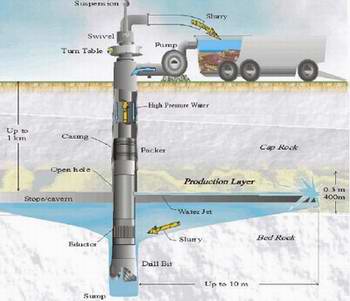
| ДонНТУ> | Портал магистров ДонНТУ> | Автобиография | Реферат | Ссылки | Результаты поиска | Инд. задание |


Первоисточник: http://www.actamont.tuke.sk/pdf/2004/n3/4dimitrievic.pdf
The 20-th Century saw the modern mining industry enriched by one outstanding method of extracting of mineral resources called Borehole Mining (BHM).
With organizing the excavation technology of loose raw materials through the boreholes, considering the complexity of technological operation, the most important thing is to calculate technical-technological parameters of exploitation and to make an optimal selection of pump aggregate, pipe line and pulp line, and also to project and construct the equipment for drilling and obtaining of concrete deposit conditions since there is no serial production. Hydro monitor presents its most important part that forms and directs the strength of water stream through the jets to break the quartz sand near the borehole, while the hydraulic elevator under the pressure lifts the pulp to the surface of the ground.
The boreholes technology uses the strength of water stream to excavate and to lift excavated materials through the boreholes. The essentional engine for the exploitation is hydro monitor there the water pass through the jet and leaves it with great velocity and so disintegration of binded sediment the quartzes sand. The mixture of water and sand (hydro mixture) are transport by the gravitation along the bottom of chamber until the opening on the casing tube in the suction zone, there the mixture by the under pressure are lift and transport through the interior pipe to the surface of the ground. By the system of horizontal hydraulic transport hydro-mixture are transporting until the settling reservoir. Sand is deposit and water by the system of over flowing comes into the sump, and thence the water is, by pump, back into the system.

The BHM method is based on in-situ water jet cutting of rock mass. On Fig. 1 the schematic of the method is presented. The borehole-mining tool 1 is lowered into the borehole 2 and high-pressure water 3 is pumped down. At the bottom part of the tool, one portion of that water comes out through the hydro monitor nozzle 4 in a shape of water jet 5 and cuts the material 6 creating slurry 7. The other portion of high-pressure water then comes to the hydro elevator 8 (jet pump, eductor), which produces a vacuum. When the slurry reaches this vacuum zone, the eductor sucks the slurry and pumps it up to the surface, where rock parts are separated from water in a tank 9 or a pond and clarified water is pumped down again closing the re-circulating BHM water supply system. The borehole-mining tool is suspended on a drill rig tower 10, which allows the tool to rotate and move vertically along the borehole axis. While extracting rock mass, underground caverns (stops) 11 are created. If necessary, compressed air 12 can be injected to the raising slurry flow to create an airlift effect. Also, a secondary agent 13 (such as oil, foam, etc.) can be added to the stop through the gap between the tool and the casing. As seen from the illustration, BHM is the remote mining method of extracting of mineral resources through boreholes by high-pressure water jets.
Since BHM takes place below the land surface, this method belongs to the underground mining category. At the same time, working personnel - miners - never go underground, but operate it from the surface, so the method is remotely operated. This equates to significant advantages in terms of a high level of safety and automatization, and the ability to work in a collapsing environment. Following, are the main borehole mining technical characteristics: Depth of mining: 15 m–1 km OD diameter of the tool: 89-305 mm, working water pressure: 7-20 MPa, flow rate: 150-300 m3*h-1, tool capacity: 30-90 m3*h-1 , slurry consistence (rock/water): 1/6-1/1, cutting reach radius - up to 10 m, thickness of developing interval 0.3-400 m.
The chief technical advantage of BHM is direct access to the production interval (ore body) where actual borehole mining takes a place. In compare to conventional mining, it allows eliminate several laborious, dangerous and expensive stages of mining process, such as overburden, shaft building, ventilation, de-watering, underground personnel transportation, life support and several more. It also minimizes safety, liquidation and re-cultivation expenses. This, in turn, decreases the overall cost of the final product dramatically: from 15% to 75%. For mining of most of natural resources and industrial minerals, it finally lowers economical break-even point far beyond the generally adopted levels allowing the development of not only small, poor, remote and difficult to access deposits, but increasing working mines reserves, as well. It also delivers an access to deposits located bellow the ocean floor. Thus, billions tons of mineral resources previously deemed “non-economical” (or even confineable) become “World’s New Reserves” globally changing the face and strategy of mining industry.
Lit.: Acta Montanistica Slovaca Rocnik 9 (2004), cislo 3, 160-167
| ДонНТУ> | Портал магистров ДонНТУ> | Автобиография | Реферат | Ссылки | Результаты поиска | Инд. задание |